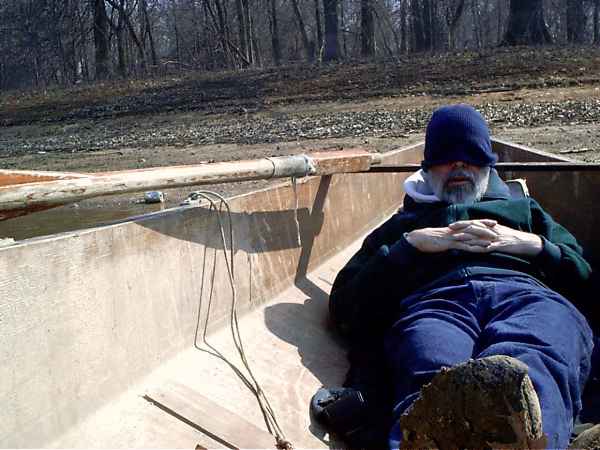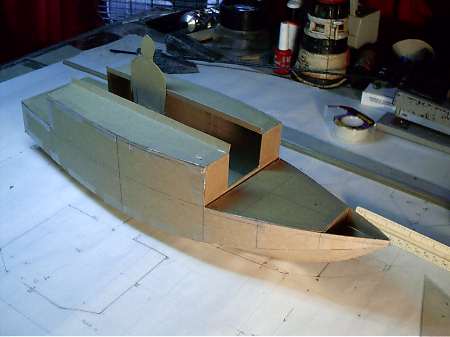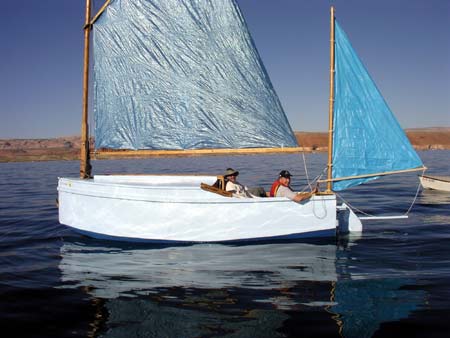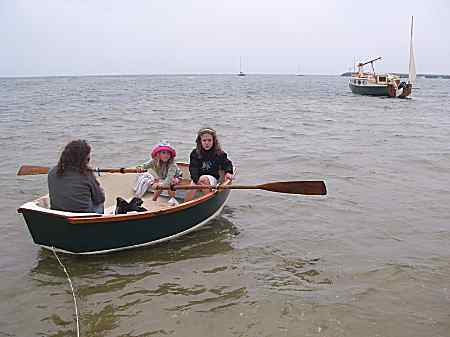
Sandra Leinweber in Imresboat on the Rio Grande, south Texas.
†
Contents:
†
Contact info:
Jim Michalak
118 E Randall,
Lebanon, IL 62254Send $1 for info on 20 boats.
†
Jim Michalak's Boat Designs
118 E Randall, Lebanon, IL 62254
A page of boat designs and essays.
(1jan08) this issue will speculate a bit on the future. The 15 January issue will rerun another knockdown article.
THE BOOK IS OUT!
BOATBUILDING FOR BEGINNERS (AND BEYOND)
is out now, written by me and edited by Garth Battista of Breakaway Books. You might find it at your bookstore. If not check it out at the....ON LINE CATALOG OF MY PLANS...
...which can now be found at Duckworks Magazine. You order with a shopping cart set up and pay with credit cards or by Paypal. Then Duckworks sends me an email about the order and then I send the plans right from me to you.

|
Left:
Sandra Leinweber in Imresboat on the Rio Grande, south Texas. † |
†
|
†
|
†
The Future, 2008
I thought I'd write down a few ramblings....
FUEL
For about five years now I've driven down the highways around St Louis and wondered how the outfits that sell big boats are staying in business. With fuel at $3 a gallon on the highway and maybe $5 a gallon on the river marinas, how does anyone think they can use a boat that uses one or two large truck engines to move? Most people are richer than I am and I guess they don't worry about it at first and they go ahead and buy such a beast. I suppose it takes about $100 to fill the tank in the usual family skiboat, and maybe the same to fill the tank on the beast you must buy to pull it down the highway. And maybe then if you are paying $300 a month to buy the boat on time, and that is every month of the year for years, and the same to buy the pulling road beast, then another $200 per weekend of use in the summer is acceptable for you family fun. At first look it seems you are spending maybe $1000 a month for that fun but remember the beasts are costing you $600 a month even if you don't use them and maybe you should spring for the fuel after all and get some use out of the thing. I know there are people out there who don't bat an eyebrow at such numbers but it makes no sense to me. And as each year goes by I see fewer and fewer of them on the lakes I use. As you may know, on summer weekdays in particular I can pretty much have a big lake to myself except for the occasional jonboat fisherman.

I've wondered if that will bring back the sailing boom of twenty five years ago, when I got started boating in a used Hobie. The summer Sunday lake was covered with pretty sailboats back then. They quickly evolved as I recall into bigger and faster and more expensive and maybe that is why they disappeared. Dave Carnell sent me an interesting article about the death of sailing surfboards - the writer noted that the boards evolved so quickly to faster and harder to use designs that after a short while there were no beginner boards available. And, as with almost all sailing, new sailors found it wasn't that easy no matter how graceful and easy it looked. And sailing wasn't the only type with that problem. Arm powered boats like kayaks and rowing boats got longer and leaner and tippier. It seems like only the classic aluminum canoes and jonboats stayed around. Even the Sunfish is seldom scene.
I guess you might see that I don't have a good feeling about extreme boats. I will let the other designers take a whack at them.
EASE OF USE
A boat has got to be easy to use or it won't get used. The true test of any boat is in how often it gets used. So I guess to me the fisherman's aluminum jonboat is the ultimate design. The folding wing trimaran is the worst.
Ideally the thing should arrive at the lake pretty much ready to go, pull up to the ramp, untie the boat and back it down into the water. Park the tow beast and go boating. You can nearly do that with a powerboat (actually those big family skiboats can be quite good at this) or an arm powered boat. You can't do it with a sailboat with a complex sail rig. In that case you need to rent a slip for the summer. If you do that then you might go ahead and get something that can't be trailer launched but you will be adding a few hundred dollars a month to the bill. But a simple sail rig can do the mission. I can launch my old 26' Bolger Birdwatcher withing ten minutes of driving into the parking lot working solo, and retrieve it as fast. So I've stuck with similar single sail rigs which make that possible and will continue to do so. Ugly and slow you say? Maybe so. But a jonboat with a ten horse motor is faster than an America's Cup racer.

Lately I've found I need to get back to boats that take to the beach easily. I've always stuck with the shallow draft that will get you there but in the olden days when I started I drew landing craft boats that let one could step ashore with ease. I think the easiest boat I ever used in that way was Karl James' prototype Jewelbox. Sail it right to the shore and step through the square bow onto dry land. It worked! Then everyone asked for pointy bows that looked like real boats. But we had to climb a lot over that point and as we got older it got harder. And the wife and kids never could do that in the first place. Actually the pointy bow will work OK as a beach boat if the freeboard is fairly low up there, say 2 feet high, as I found with Chris Feller's Philsboat. Sit on that low deck and swing your legs down to the beach or up into the boat depending on which direction you are headed.
SAFETY
By this I mean seaworthyness mostly. Lately I've come to think that the safest boats are those with the least capability. Nobody is going to drown in a one sheet of plywood dink because it clearly is unsafe and you won't go awandering with it. But the guy with a press on regardless design has to do a lot of soul searching. There will exist at one time or another conditions which will undo his boat and him inside it. And when that happens there will be no one around to save him.
Question - "Can I go offshore with your design XXX?" Answer - "It doesn't matter which design XXX is, if you have to ask then the answer for you is NO." Why? Because I've never sailed offshore and don't really know what is involved. And if you have to ask me then you don't know either. Right? Not to say that XXX can't be taken offshore successfully by someone who is experienced (by working up to it a step at a time) or dumb lucky. But the experienced and the dumb lucky wouldn't be asking me if it were safe.
I think seaworthiness comes from several factors. One would be hull shape. Round bottoms and long pointy bows go through rough water a lot better than boxes. I'm not talking about speed here (although they are faster too) but ease of handling. The box boat will sooner reach a point where it won't turn as you want and then you are in trouble.
Another factor would be simplicity of the sail rig. A sail boat is sort of like a marionette controlled by strings. The more strings the more things it will do. But when the crap hits the fan in a big blow you won't be able to deal with all the strings. Simpler is better although I must say that a good mizzen sail will allow a solo man to reef a mainsail while afloat and it really can't be done otherwise in the conditions where reefing is required.

So I'm gonna stay with the simple single sail rigs but won't fight much if you say you need a mizzen. By the way, the balanced lug sails I prefer aren't the best rough water rigs, I am pretty sure of that. Like the gaff sail it has a loose yard aloft which can scare you in rough going. I suppose the sharpie sprit might be better here but a sharpie sprit is very hard to reef well. It takes a lot of thought and practice to come up with a sail rig that reefs well.
Another comment about safety here is that there have been some swampings of boats like AF3. The open cabin slots need to be covered and sealed to prevent the swampings. I've never yet heard of one going turtle and don't really see that happening with a wooden sail rig. But if the cabin swamps you will need help to rescue. You have to take it seriously. I need to make the openings smaller but then the builders keep making them bigger, a problem that goes back to my first designs like Piccup.
Right now I think the Birdwatcher cabin design is the safest thing around provided it has been tested to see if a smattering of ballast is needed to self right. I try to predict that with a computer model but real life has shown for example that Scram Pram needs some ballast to self right but IMB didn't. I can explain that away but remember that each homemade boat is different. I think the Birdwatcher cabin might be safer than the traditional ballasted cabin boat which requires an all over deck to prevent swamping and sinking in a knockdown. Then the crew has to sit up high on that all over deck and that becomes the critical part of the self righting equation. Add to this that nobody really likes to put all that weight down in the belly of their boat, or fill a water ballast tank for that matter, and then you are sailing around without the full amount of ballast on that nice mild day - and then the thunderstom pops up. And when she gets knocked down the crew might get thrown into the water. Relieved of her topside crew weight the boat self rights now, minus crew. This is a real life scenerio. At least the BW cabin has everyone stuck inside, the lower they get the better she self rights.
BUILDING COMPLEXITY
You know, that has never really been a problem. I don't think I have the attention span needed to design a boat that most of you can't build. I can tell right off with a paper design how hard it is going to build with few exceptions. Harder to design = harder to build. Lots of parts = harder to build. Takes twice as long to design a sailboat compared to a power or rowboat = takes twice as long to build one. I'm convinced.
THE FLOATING BATHROOM
OK, half of the questions I field involve this. Man has to have a bathroom on his boat because his family won't go boating without. I understand that. Must have standing room inside, too. OK, here is the only solution....

Well, I'm making light of this but it just can't be done in anything less than 25' if then. Many boats have been designed around a potty but I haven't done that yet. And here is why. Let's say your wife won't go boating with you because there is no potty on your present boat. You scrap it and build the 25 footer. She finds a different reason to not go boating......
Always build a boat for yourself.
Caroline

CAROLINE, SAILBOAT, 18' X 6', 750 POUNDS EMPTY
Caroline started as a blend of Philsboat and Frolic2. The idea was for a little more cabin room than Philsboat and hopefully with the same seakeeping ability that Frolic2 has demonstrated. I made it a little deeper and wider and with a longer cabin than Philsboat. It all added up to about 30% more cabin volume. But it is also more boat to build and pay for and haul so the other boats, which are lighter and cheaper, still havenít been made obsolete as far as I am concerned.

One interesting side to this sort of house design is that if you add a motor well, as this one has, the stern gets pretty busy since the only way you can run a normal tiller to the rudder is under the aft deck. To get a good swing of the rudder that aft deck needs to be short and wide if that motor is to live there too. I think I have it all crammed in there such that it might work but even so the rudder is well offset to one side, as it was successfully done with Philsboat.

The builder wanted a yawl rig (she wants to coastal cruise the Maine coast) but I added the mizzen as I do now, keeping the basic balance such that you could sail it without the mizzen.
Looks like six sheets of ľ", ten sheets of 3/8" and three sheets of Ĺ". Taped seam construction.
Plans for Caroline are $35 until one is built and tested.
Prototype News
Some of you may know that in addition to the one buck catalog which now contains 20 "done" boats, I offer another catalog of 20 unbuilt prototypes. The buck catalog has on its last page a list and brief description of the boats currently in the Catalog of Prototypes. That catalog also contains some articles that I wrote for Messing About In Boats and Boatbuilder magazines. The Catalog of Prototypes costs $3. The both together amount to 50 pages for $4, an offer you may have seen in Woodenboat ads. Payment must be in US funds. The banks here won't accept anything else. (I've got a little stash of foreign currency that I can admire but not spend.) I'm way too small for credit cards.
I think David Hahn's Out West Picara is the winner of the Picara race. Shown here on its first sail except there was no wind. Hopefully more later. (Not sure if a polytarp sail is suitable for a boat this heavy.

Here is a Musicbox2 I heard about through the grapevine.

This is Ted Arkey's Jukebox2 down in Sydney. Has a temporary rig and he is working on the blueprint rig.

And the Vole in New York is Garth Batista's of www.breakawaybooks.com, printer of my book and Max's book and many other fine sports books. Boat is done, shown here off Cape Cod with mothership Cormorant in background, Garth's girls are one year older. Beautiful job! I think Garth is using a small lug rig for sail, not the sharpie sprit sail shown on the plans, so I will continue to carry the design as a prototype boat.

And the Leinweber's make another prototype! This one by Sandra, an Imresboat shown here on its first outing. They are taking it on a "cruise" so more about it later.

AN INDEX OF PAST ISSUES
Hullforms Download (archived copy)
Plyboats Demo Download (archived copy)
Brokeboats (archived copy)
Brian builds Roar2 (archived copy)
Herb builds AF3 (archived copy)
Herb builds RB42 (archived copy)